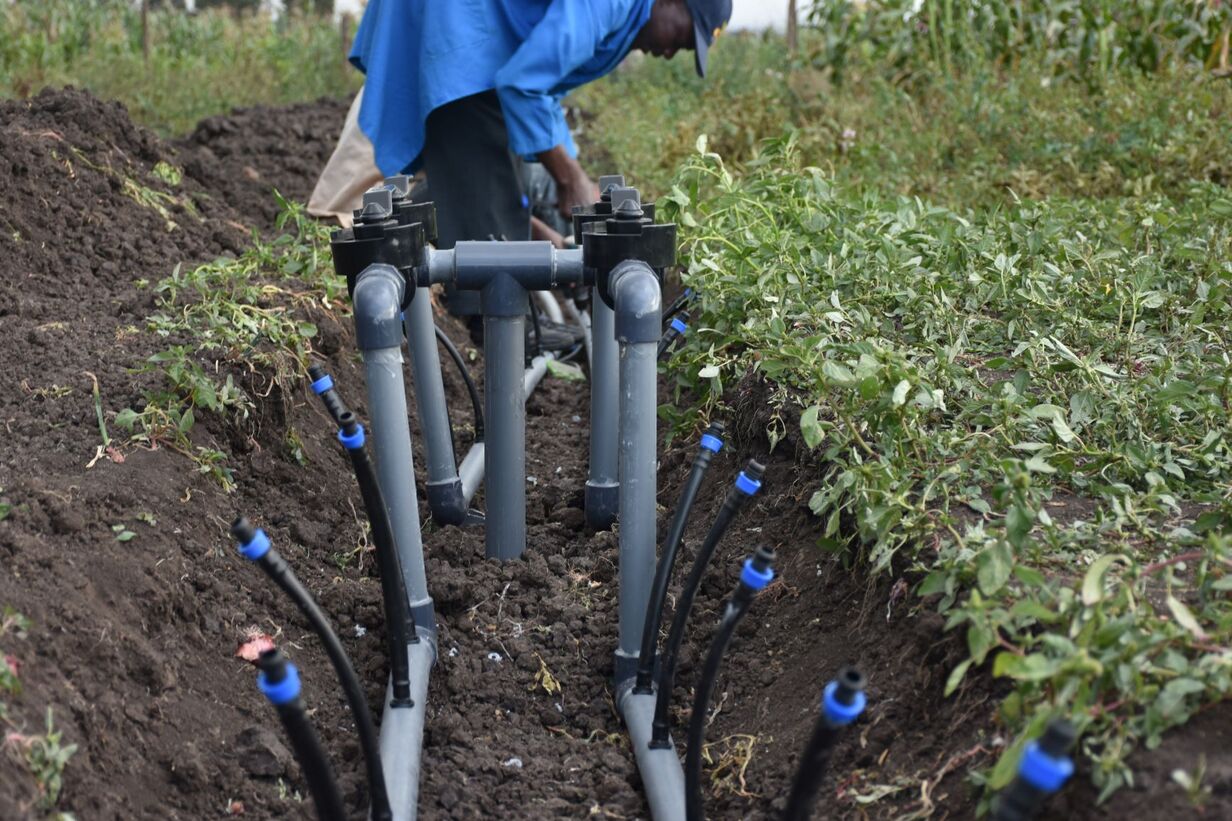Home>Gardening News and Trends>Latest News>What Destroyed The Indus Valleys Irrigation System


Latest News
What Destroyed The Indus Valleys Irrigation System
Published: November 18, 2023
Get the latest news on what caused the destruction of the Indus Valley's irrigation system. Discover the fascinating revelations and theories.
(Many of the links in this article redirect to a specific reviewed product. Your purchase of these products through affiliate links helps to generate commission for Chicagolandgardening.com, at no extra cost. Learn more)
Table of Contents
Introduction
The Indus Valley Civilization, one of the oldest urban civilizations in the world, flourished around 2500 BCE in the region that encompasses modern-day Pakistan and northwest India. This ancient civilization is known for its advanced urban planning, sophisticated drainage systems, and remarkable architecture.
One of the key features that contributed to the success of the Indus Valley Civilization was its intricate irrigation system. The inhabitants of this civilization relied heavily on agriculture, and the availability of a reliable water supply was crucial for their survival. The sophisticated irrigation system enabled the cultivation of crops on a large scale, sustaining a thriving agricultural economy.
However, despite its early advancements in irrigation, the Indus Valley Civilization experienced a mysterious decline and eventual collapse around 1900 BCE. The exact reasons behind this collapse are still debated by archaeologists and historians, but one significant factor that is widely acknowledged is the destruction of the irrigation system.
This article aims to explore the importance of irrigation in the Indus Valley Civilization and the factors that contributed to the destruction of its irrigation system. Additionally, it will examine the consequences of this destruction and various theories proposed to explain its demise.
Ancient Irrigation Systems
Throughout human history, civilizations have recognized the importance of water for agriculture and have devised various methods to harness this vital resource. Ancient irrigation systems played a crucial role in the development and sustenance of early societies.
Ancient civilizations, such as the Mesopotamians, Egyptians, and Chinese, understood the need to control water flow and distribution to ensure the success of their agricultural endeavors. They built intricate canal networks, reservoirs, and dams to manage water supply and irrigation.
One of the earliest known irrigation systems can be traced back to around 6000 BCE in Mesopotamia, where the Sumerians utilized canals to divert water from the Tigris and Euphrates rivers to irrigate their fields. Similarly, the ancient Egyptians relied on the annual flooding of the Nile River to irrigate their farmland, implementing a system of channels and dikes.
The construction of these ancient irrigation systems required advanced engineering skills and meticulous planning. It involved the excavation of canals, the creation of embankments, and the construction of structures to regulate water flow. These systems provided a consistent water supply to agricultural lands, enabling farmers to cultivate crops and sustain their communities.
In addition to facilitating agriculture, irrigation systems also had other benefits. They served as transportation routes, providing a means for the transportation of goods and people. They also contributed to the growth of population centers and urbanization, as the availability of water allowed for the establishment of larger settlements.
Furthermore, ancient irrigation systems fostered social and economic development. The surplus agricultural produce resulting from the efficient use of water resources allowed for specialization of labor, the growth of trade, and the development of complex societies.
Without the advancements in irrigation systems, ancient civilizations would not have been able to thrive and achieve the level of progress that they did. These systems formed the backbone of their agricultural economies, ensuring a stable food supply and contributing to the overall prosperity of the civilization.
Overview of the Indus Valley Civilization
The Indus Valley Civilization, also known as the Harappan Civilization, is one of the earliest urban civilizations in the world. It emerged around 2500 BCE in the fertile floodplain of the Indus River, which flows through present-day Pakistan and northwest India.
Spanning an area of over 1.5 million square kilometers, the Indus Valley Civilization thrived for nearly a thousand years, until its decline and eventual collapse around 1900 BCE. Its major cities, such as Mohenjo-daro and Harappa, exhibited remarkable urban planning, with organized grids of streets, complex drainage systems, and advanced architecture.
The Indus Valley Civilization was characterized by its sophisticated trade networks, evidence of craft specialization, and writing system, which has yet to be fully deciphered. The people of this civilization engaged in agriculture, with wheat, barley, and various fruits and vegetables being cultivated.
The society of the Indus Valley Civilization was organized in a hierarchical manner, with evidence of a ruling elite and a complex social structure. Religion also played an important role, as evidenced by the presence of ritual bathing areas, fire altars, and figurines believed to represent deities.
What sets the Indus Valley Civilization apart from other ancient civilizations is its well-developed urban infrastructure. The cities were laid out in a grid pattern, with well-planned streets and well-designed buildings. The drainage systems, equipped with covered drains, were surprisingly advanced for their time. This demonstrates the civilization’s commitment to public health and sanitation.
Despite its remarkable achievements, the Indus Valley Civilization faced a decline and eventual collapse. The reasons behind this decline are still unclear, but several theories have been proposed, including environmental factors, economic issues, and external invasions.
The Indus Valley Civilization remains a fascinating subject of study, providing valuable insights into early urbanization, complex societies, and the importance of water management and agriculture in ancient civilizations.
Importance of Irrigation in the Indus Valley
Irrigation played a vital role in the success and prosperity of the Indus Valley Civilization. The inhabitants of this ancient civilization relied heavily on agriculture as their primary source of sustenance and economic activity. The availability of a reliable water supply was paramount to their survival and the flourishing of their society.
In the Indus Valley, agriculture was mainly practiced along the banks of the Indus River and its tributaries. These rivers provided a consistent water source for irrigation, allowing farmers to cultivate crops throughout the year. The advanced irrigation system implemented by the Harappans enabled the distribution of water to agricultural fields, ensuring optimal growth and productivity of crops.
The development of an efficient irrigation system allowed the Indus Valley Civilization to cultivate a variety of crops, including wheat, barley, millet, sesame, peas, and cotton. This diverse range of crops contributed to a stable food supply and supported the growth of the population.
The use of irrigation techniques also enabled the cultivation of crops during the dry season, mitigating the impact of water scarcity. Canals and water channels were strategically designed to divert and distribute water, ensuring that even the farthest agricultural lands received sufficient water for cultivation.
Furthermore, the Indus Valley Civilization practiced intensive agriculture. The availability of irrigation allowed for the cultivation of crops in multiple seasons, increasing the overall productivity of the land. This surplus production likely contributed to trade and socio-economic development within the civilization.
The success of the Indus Valley’s irrigation system is evident from the large-scale granaries found in the cities, indicating the efficient storage and management of agricultural produce. These granaries served as central hubs for collecting and distributing surplus crops, further promoting economic growth and stability.
In addition to supporting agriculture, the irrigation systems of the Indus Valley played a role in shaping the civilization’s culture and identity. Water was regarded as a sacred element by the Harappans, and this reverence for water is reflected in the presence of ritual bathing areas and the depiction of water-related deities in their art and religious practices.
The importance of irrigation in the Indus Valley Civilization cannot be overstated. It was the foundation of their agricultural economy, ensuring food security, economic prosperity, and societal development. The remarkable engineering and planning involved in their irrigation system demonstrate the ingenuity and sophistication of this ancient civilization.
Factors Affecting the Indus Valley Irrigation System
While the Indus Valley Civilization boasted an advanced and successful irrigation system, several factors contributed to the eventual destruction and decline of this vital infrastructure. These factors, both natural and anthropogenic, played a significant role in compromising the sustainability and functionality of the irrigation system.
One major factor was environmental changes. The Indus Valley region experienced shifts in climate patterns, including changes in rainfall and fluctuations in the flow of rivers. These alterations affected the availability and distribution of water for irrigation purposes. Droughts, floods, and changes in river courses disrupted the delicate balance of the irrigation system, leading to reduced agricultural productivity.
Over time, the Indus River itself, which was the primary water source for the irrigation system, changed its course. This shift resulted in the abandonment of previously fertile agricultural lands as the water source moved away. The loss of access to the river water severely impacted the viability of the irrigation system and led to decreased agricultural output.
Moreover, deforestation and soil degradation posed significant challenges to the sustainability of the irrigation system. The clearing of forests for agricultural expansion and fuel consumption disrupted the hydrological cycle, leading to soil erosion and reduced water-holding capacity of the land. This, in turn, affected the efficiency of irrigation techniques, as the water could not be effectively absorbed by the degraded soils.
Additionally, sedimentation and siltation in the rivers and canals impacted the functionality of the irrigation system. Over time, the accumulation of sediments and silt reduced the water-carrying capacity of the channels, leading to inefficient irrigation and decreased agricultural production.
Anthropogenic factors also played a role in the deterioration of the irrigation system. The increasing population and urbanization in the Indus Valley Civilization put a strain on the water resources, leading to overexploitation of water for agriculture and domestic use. This overuse exerted pressure on the irrigation infrastructure, compromising its effectiveness and contributing to its eventual decline.
The decline of the Indus Valley irrigation system was a complex interplay of environmental, climatic, and human factors. The combination of shifting rivers, environmental degradation, and overuse of water resources undermined the sustainability of the system and ultimately led to the collapse of the once-thriving agricultural economy.
Consequences of the Destruction of the Indus Valley Irrigation System
The destruction and decline of the Indus Valley Civilization’s irrigation system had far-reaching consequences for the society and economy of this ancient civilization. The collapse of the irrigation infrastructure had a profound impact on various aspects of life in the Indus Valley.
One of the immediate consequences was a decline in agricultural productivity. Without a reliable irrigation system, the once fertile lands of the Indus Valley became arid and infertile, resulting in decreased crop yields. The loss of access to a consistent water supply led to food shortages, making it difficult for the population to sustain itself. Agriculture, which had been the backbone of the civilization’s economy, suffered a severe blow.
The consequences of the destroyed irrigation system extended beyond the sphere of agriculture. With the decline in agricultural production, trade and commerce also suffered. The surplus crops that were once traded within the civilization and with neighboring regions dwindled, impacting the economic prosperity of the Indus Valley. The decline in trade further weakened the civilization’s economy, contributing to its eventual collapse.
The destruction of the irrigation system also had social and demographic consequences. The decline in agricultural productivity resulted in a decline in the population as people migrated in search of better resources and livelihoods. The abandonment of previously cultivated lands and the diminishing availability of water led to the dispersal and fragmentation of communities, destabilizing the social fabric of the Indus Valley Civilization.
Furthermore, the collapse of the irrigation system had environmental consequences. The removal of sustainable irrigation practices and the subsequent decrease in agricultural activity led to the degradation of the land. Desiccation and soil erosion occurred, causing further ecological damage. The destruction of the irrigation system disrupted the delicate balance of the ecosystem in the Indus Valley, contributing to long-term environmental degradation.
The consequences of the destruction of the irrigation system in the Indus Valley Civilization were multifaceted and interconnected. The decline in agricultural productivity, economic instability, population displacement, and ecological damage all worked together to hasten the collapse of this once-thriving urban civilization.
Theories on What Caused the Destruction
The exact reasons behind the destruction and collapse of the Indus Valley Civilization continue to be a subject of debate and speculation among archaeologists and historians. Several theories have been proposed to explain the downfall of this once-thriving urban civilization, each shedding light on different aspects that may have contributed to its demise.
One theory suggests that environmental factors played a significant role in the destruction of the Indus Valley Civilization. The region experienced major climate changes, including shifts in rainfall patterns and the drying up of rivers. Prolonged droughts and decreased water availability would have severely impacted the agricultural productivity and sustainability of the civilization’s irrigation system.
Another theory suggests that the collapse of the civilization was due, in part, to the occurrence of natural disasters, such as floods and earthquakes. The Indus Valley region is known for its seismic activity, and catastrophic events could have caused the destruction of infrastructure, including the irrigation system, and the displacement or loss of the population.
Social and political factors have also been proposed as possible causes. Some scholars believe that internal conflicts, class divisions, or the emergence of a ruling elite that monopolized resources and power may have contributed to social unrest and destabilization. The breakdown of social cohesion and the inability to effectively manage and maintain the irrigation system may have hastened the decline of the civilization.
External factors, such as invasions or interactions with neighboring cultures, have also been considered. It is possible that external forces, such as conquerors or migrations of other groups into the region, led to the destruction of infrastructure and disrupted the societal and economic fabric of the Indus Valley Civilization.
Furthermore, it is worth considering the possibility of a combination of factors working together to bring about the downfall of the civilization. It is likely that a complex interplay of environmental, social, political, and external factors contributed to the destruction of the infrastructure, including the irrigation system, which ultimately led to the collapse of the Indus Valley Civilization.
While each theory presents valuable perspectives on the potential causes of the civilization’s destruction, the exact sequence of events and the primary catalyst for its downfall remain elusive. Further research and archaeological discoveries will continue to shed light on this ancient mystery, allowing us to gain a clearer understanding of the factors that led to the destruction of the Indus Valley Civilization.
Conclusion
The Indus Valley Civilization, with its advanced urban planning and sophisticated irrigation system, was a testament to the early ingenuity and human endeavor. The civilization’s reliance on irrigation for agriculture and its ability to sustain a thriving agricultural economy played a crucial role in its success and prosperity.
However, the decline and eventual collapse of the Indus Valley Civilization were marked by the destruction of its irrigation system. Factors such as environmental changes, including shifts in climate patterns and river courses, as well as anthropogenic influences like deforestation and overuse of water resources, contributed to the degradation of the irrigation infrastructure.
The consequences of the destruction of the irrigation system were far-reaching. The decline in agricultural productivity, economic instability, population displacement, and environmental degradation all played a part in the downfall of the civilization. The loss of the sophisticated irrigation system disrupted the delicate balance of the ecosystem and had a profound impact on the social, economic, and environmental aspects of life in the Indus Valley.
Various theories have been proposed to explain the causes of the destruction, ranging from environmental factors and natural disasters to social and political unrest, as well as external conquests. It is likely that a combination of these factors, working in conjunction, led to the collapse of this once-thriving urban civilization.
Despite the mystery surrounding its demise, the Indus Valley Civilization remains an important part of human history and a testament to the ingenuity of early civilizations. The lessons learned from their advanced irrigation system can still be applied today, underscoring the importance of sustainable water management and the critical role of a reliable water supply for agriculture and societal development.
As archaeological research continues and new discoveries are made, we hope to gain a deeper understanding of the factors that contributed to the destruction of the Indus Valley Civilization. By unraveling the mysteries of the past, we can gain valuable insights into how early civilizations interacted with their environment and the challenges they faced, providing us with valuable lessons for sustainable development in the present and future.







